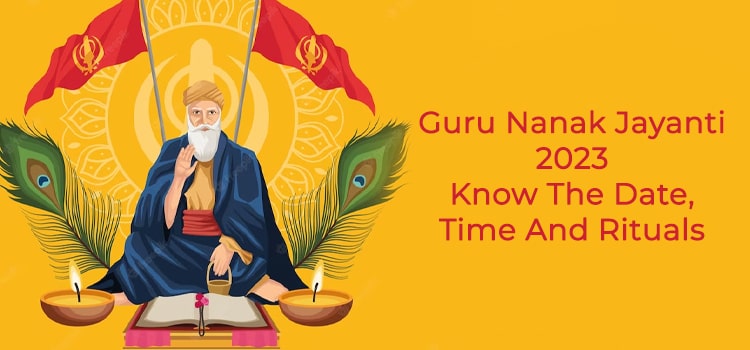Guru Nanak Jayanti is a major Sikh festival that celebrates the birth of Guru Nanak Dev, who founded Sikhism. He was the first among the 10 Sikh Gurus. These Sikh Gurus were the ones who shaped the beliefs of the Sikhs. Their birthdays are called Gurpurab and are important occasions for celebration and prayer among the Sikh community. Guru Nanak Dev’s key message was that anyone could connect to God if they worshipped with a clear conscience. His teachings are found in the sacred Sikh book Guru Granth Sahib.
Guru Nanak Jayanti is on the full moon day in the month of Kartik. On this day, the celestial alignment generates a powerful energy that is ideal for spiritual growth and enlightenment.

Guru Nanak Jayanti 2023: Date & Time
Guru Nanak Jayanti 2023 is on Monday, November 27, 2023. The auspicious Purnima
Tithi starts at 03:53 pm on November 26 and ends at 02:45 pm on November 27. On this day, followers of the Sikh faith honor the Guru and his teachings. Guru Nanak Jayanti symbolizes spiritual enlightenment and the victory of righteousness. Devotees gather together at gurudwaras, offer prayers, sing hymns, meditate, and seek divine blessings.
Guru Nanak Jayanti Celebrations
Guru Nanak Jayanti is a vibrant festival that has a lot of significance for the Sikh community worldwide. The festival commences with the recitation of the Guru Granth Sahib, the sacred Sikh scripture.
Devotees begin the proceedings by assembling at the gurudwaras. They sing kirtans and recite holy verses. They take part in Nagar Kirtan, a procession led by Sikhs. During the procession, they spread the teachings and messages of Guru Nanak Dev. On this day, people recall his teachings and vow to lead a life of righteousness and compassion.
On the day of the Jayanti or Gurpurab, the celebrations begin early in the morning, at around 4 to 5 am. This time is called Amrit Vela. The day commences with the singing of Asaa-Ki-Vaar (morning hymns). Following this is a combination of Katha (scriptural exposition) and Kirtan (hymns from the Sikh scriptures) that praises the Guru. Then follows the Langar, a special community lunch. This is arranged at the Gurudwaras by volunteers. The idea behind the Langar is that everyone, irrespective of gender, caste, class, or creed, should be given food in the spirit of seva (service) and bhakti (devotion).
Night prayer sessions may also take place in some Gurudwaras. They usually begin around sunset when Rehras (evening prayer) is recited. This is followed by Kirtan till late at night. The congregation begins to sing Gurbani at about 1:20 am., which is the actual time of Guru Nanak’s birth. The celebrations conclude at around 2 am.
Guru Nanak Jayanti is also an occasion for introspection. Devotees pledge to follow the Guru’s values of equality, unity, and compassion in their daily lives and do their bit for the welfare of society. The festival brings together people from diverse backgrounds, thereby creating a sense of unity and harmony. It also strives to encourage interfaith dialogue and understanding by stressing the importance of tolerance and respect for all faiths.
Rituals of Guru Nanak Jayanti
The day starts with “Prabhat Pheri,” which is an early morning procession. Sikhs of the neighborhood gather and sing hymns praising Guru Nanak. The procession starts at gurudwaras and makes its way through the streets, spreading the message of peace and love. Both young and old people take part in the procession. The atmosphere is very vibrant and spiritual.
An important ritual related to the Guru Nanak Jayanti celebrations is “Akhand Path,” that is, the continuous reading of the Sikh holy book, Guru Granth Sahib. People take turns to read passages from the holy book without any break in the reading. It takes around 48 hours for the reading to end. The entire community is present on this occasion. This ritual usually takes place two days before the Jayanti.
Playing a vital role in the festivities is the Langar or the community kitchen. The Sikh devotees volunteer to cook and serve free meals to all, irrespective of their caste, creed, or social status. The ideas of equality and selfless service are deeply rooted in the Sikh religion. The Langar is an expression of these ideas.
“Nagar Kirtan,” a grand procession through the streets, is another major ritual of Guru Nanak Jayanti. It takes place the day before the Jayanti. Carrying their holy book, the Guru Granth Sahib, on a decorated palanquin, Sikhs march through the streets. They also chant hymns and sing devotional songs with the intent of spreading the teachings of Guru Nanak to everyone.
The Panj Pyaras (Five Beloved Ones) lead the procession, carrying the Sikh flag, or Nishan Sahib, and the Palki (Palanquin) of Guru Granth Sahib. Groups of singers follow them, singing hymns, while devotees sing the chorus. Brass bands play a medley of tunes, and 'Gatka' teams show off their swordsmanship by engaging in martial arts and mock battles, wielding traditional weapons. The procession passes through the streets. The passage is covered with banners, while gates are decorated with flags and flowers on this special occasion.
The celebrations come to an end with “Gurbani Kirtan.” In this ritual, devotees gather in Sikh temples/gurudwaras and listen to melodious hymns and devotional music. The Kirtan is performed by professional Ragi (musicians) perform the Kirtan. It is a very meditative experience that has an uplifting effect on the soul.
Conclusion
Guru Nanak Jayanti is a major festival in the Sikh calendar. The celebrations are especially grand and colorful in places like Punjab, Haryana, Chandigarh, etc., which have a sizeable population of Sikhs. Some Sindhis, too, celebrate this festival.








